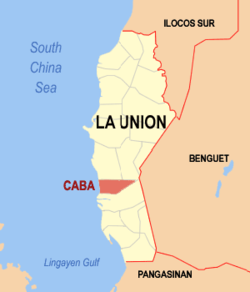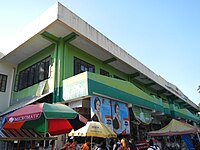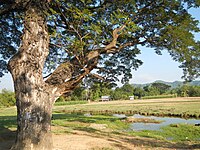world.wikisort.org - Philippines
Caba, officially the Municipality of Caba (Ilocano: Ili ti Caba; Filipino: Bayan ng Caba), is a 4th class municipality in the province of La Union, Philippines. According to the 2020 census, it has a population of 23,119 people. [3]
This article uses bare URLs, which are uninformative and vulnerable to link rot. (September 2022) |
Caba | |
|---|---|
Municipality | |
| Municipality of Caba | |
 Caba town center along the National Highway | |
| Motto: "Arriba Dur-As Caba" | |
| Anthem: Caba Hymn | |
 Map of La Union with Caba highlighted | |
OpenStreetMap  | |
 Caba Location within the Philippines | |
| Coordinates: 16°25′54″N 120°20′41″E | |
| Country | Philippines |
| Region | Ilocos Region |
| Province | La Union |
| District | 2nd district |
| Barangays | 17 (see Barangays) |
| Government | |
| • Type | Sangguniang Bayan |
| • Mayor | Philip Caesar P. Crispino |
| • Vice Mayor | Ronnie P. Mangaser |
| • Representative | Sandra Y. Eriguel |
| • Municipal Council | Members |
| • Electorate | 16,614 voters (2019) |
| Area | |
| • Total | 46.31 km2 (17.88 sq mi) |
| Elevation | 41 m (135 ft) |
| Highest elevation | 299 m (981 ft) |
| Lowest elevation | 0 m (0 ft) |
| Population | |
| • Total | 23,119 |
| • Density | 500/km2 (1,300/sq mi) |
| • Households | 5,070 |
| Economy | |
| • Income class | 4th municipal income class |
| • Poverty incidence | 3.11% (2018)[4] |
| • Revenue | ₱94,976,329.82 (2020) |
| • Assets | ₱331,117,143.74 (2020) |
| • Expenditure | ₱132,657,695.78 (2020) |
| • Liabilities | ₱33,443,136.10 (2020) |
| Service provider | |
| • Electricity | La Union Electric Cooperative (LUELCO) |
| Time zone | UTC+8 (PST) |
| ZIP code | 2502 |
| PSGC | |
| IDD : area code | +63 (0)72 |
| Native languages | Ilocano Pangasinan Tagalog |
| Website | www |
Caba was a part of the municipality of Aringay until the late-19th century when it was permanently separated to form its own entity. It has a land area of 4,631 hectares (11,440 acres). [5]
History
This section needs additional citations for verification. (August 2013) |
History records show that this municipality used three names interchangeably: Caba, Cava, and Caua. According to a local historian Pedro Manongdo, two tales have persisted on how the town got his name. One group referred to an incident when a Spaniard asked an inhabitant the name of the place. The youth mistook the question as an inquiry to the name of the animal he was herding and answered “Cava.” The repetition of the name ended with Cava and later Caba.
Another story sustained that Caba was the name given by a group of immigrants from barrio Caba, San Carlos, Pangasinan who settled in the community in the later years of the 16th century. In memory of the place where they came from, they named the new settlement CABA.
Caba was founded as a settlement in 1598 by Augustinian Fathers with Don Agustin dela Cruz as the “first man to rule.” The settlement developed into barangay in 1692 with don Luis Manongdo as the Cabeza de barangay. It became a town in 1783 with Don Domingo Aragon as gobernadorcillo.
Two other historians however have claimed different dates on the founding of Caba as a town. On one hand, Father Jose Braganza, SVD claims that Caba was founded in 1745 along with Aringay. On the other hand, Julian Martin claims that Caba was founded in 1844.

In 1903, the Philippine commission reorganized the administrative and territorial set-up of municipalities in the country. Due to a meager population of financial difficulties, some smaller municipalities were integrated. Caba was integrated with Aringay while Santo Tomas to Agoo.
In 1907, Executive Order no. 41 was issued which provided that Caba be separated from Aringay. The order took effect on January 1, 1908, thus Caba again became a regular municipality with Francisco Sobredillo as Chief Executive.
Caba is the birthplace of Diego Silang, the inspiration and the leader of the Ilocos Revolt of 1762-1763. During the Spanish period, Silang established an independent rebel government in Northern Luzon and agitated for reforms in and out of the government. However, Spanish authorities resorted to assassinating him with the help of one of his followers who betrayed him with a shot in his back on May 28, 1763. The assassin's bullet did not however smother the flame of Silang rebellion. His wife Gabriella took the torch of leadership and by her own right, continued the rebellion heroically. Four months later, she was captured by Spanish forces and was executed publicly in Vigan on September 20, 1763, thus ended not only the heroic adventure of the “Ilocandia’s Joan of Arc” but also Silang's revolt.[6] A predominantly Roman Catholic municipality. In 1997 the Roman Catholic Church Celebrated its 400 years of Christianity basing on church's documents
Geography
Caba is located 248 kilometres (154 mi) from Metro Manila and 21 kilometres (13 mi) from San Fernando, the provincial capital.
Barangays
Caba is politically subdivided into 17 barangays. [5] These barangays are headed by elected officials: Barangay Captain, Barangay Council, whose members are called Barangay Councilors. All are elected every three years.
- Bautista
- Gana
- Juan Cartas
- Las-ud
- Liquicia
- Poblacion Norte
- Poblacion Sur
- San Carlos
- San Cornelio
- San Fermin
- San Gregorio
- San Jose
- Santiago Norte
- Santiago Sur
- Sobredillo
- Urayong
- Wenceslao
Climate
| Climate data for Caba, La Union | |||||||||||||
|---|---|---|---|---|---|---|---|---|---|---|---|---|---|
| Month | Jan | Feb | Mar | Apr | May | Jun | Jul | Aug | Sep | Oct | Nov | Dec | Year |
| Average high °C (°F) | 30 (86) |
32 (90) |
33 (91) |
34 (93) |
33 (91) |
31 (88) |
30 (86) |
29 (84) |
30 (86) |
31 (88) |
31 (88) |
31 (88) |
31 (88) |
| Average low °C (°F) | 20 (68) |
21 (70) |
22 (72) |
24 (75) |
25 (77) |
25 (77) |
25 (77) |
25 (77) |
24 (75) |
23 (73) |
22 (72) |
23 (73) |
23 (74) |
| Average precipitation mm (inches) | 15 (0.6) |
16 (0.6) |
24 (0.9) |
33 (1.3) |
102 (4.0) |
121 (4.8) |
177 (7.0) |
165 (6.5) |
144 (5.7) |
170 (6.7) |
56 (2.2) |
23 (0.9) |
1,046 (41.2) |
| Average rainy days | 6.3 | 6.6 | 9.5 | 12.8 | 20.6 | 23.5 | 25.4 | 23.4 | 23.2 | 21.4 | 14.0 | 8.2 | 194.9 |
| Source: Meteoblue[7] | |||||||||||||
Demographics
| Year | Pop. | ±% p.a. |
|---|---|---|
| 1903 | 3,967 | — |
| 1918 | 5,860 | +2.64% |
| 1939 | 6,873 | +0.76% |
| 1948 | 7,320 | +0.70% |
| 1960 | 9,517 | +2.21% |
| 1970 | 11,719 | +2.10% |
| 1975 | 13,029 | +2.15% |
| 1980 | 14,114 | +1.61% |
| 1990 | 16,620 | +1.65% |
| 1995 | 18,234 | +1.75% |
| 2000 | 19,565 | +1.52% |
| 2007 | 20,927 | +0.93% |
| 2010 | 21,244 | +0.55% |
| 2015 | 22,039 | +0.70% |
| 2020 | 23,119 | +0.95% |
| Source: Philippine Statistics Authority [8] [9] [10][11] | ||
In the 2020 census, the population of Caba, La Union, was 23,119 people, [3] with a density of 500 inhabitants per square kilometre or 1,300 inhabitants per square mile.
Religion

- Assemblies of God (Poblacion Norte)
- Assemblies of God (San Jose)
- Assemblies of the First Born (Gana)
- Assemblies of the First Born (Juan Cartas)
- Assemblies of the First Born (Liquicia)
- Assemblies of the First Born (San Cornelio)
- Assemblies of the First Born (San Jose)
- Assemblies of the First Born (Sobredillo)
- Assemblies of the First Born (Urayong)
- Christ Centered Fellowship (Juan Cartas)
- Faith Gospel Mission Church/Yes for Jesus Crusaders International (Poblacion Norte)
- Iglesia Filipina Independiente (Poblacion Norte)
- Iglesia Ni Cristo (Gana)
- Jesus Christ The Glorious Savior International Ministry JCGSIM LU [Full Gospel Christian Church] (Poblacion Norte)[12]
- Messengers of the Cross Bible College/Assemblies of the First Born Full Gospel Church (Poblacion Norte)
- Shinil Caba Christian Fellowship (Poblacion Norte)
- The Lord's Vineyard Baptist Church (Las-ud)
- United Church of Christ in the Philippines (Poblacion Norte)
- Words of Life Christian Ministries (Santiago Norte)
Economy
Government
Just as the national government, the municipal government of Caba, is divided into three branches: executive, legislative, and judiciary. The judicial branch is administered solely by the Supreme Court of the Philippines. The LGUs have control of the executive and legislative branches.
The executive branch is composed of the mayor and the barangay captain for the barangays.Local Government Code of the Philippines, Book III, Department of the Interior and Local Government official website.
The legislative branch is composed of the Sangguniang Bayan (town assembly), Sangguniang Barangay (barangay council), and the Sangguniang Kabataan for the youth sector.
The seat of Government is vested upon the Mayor and other elected officers who hold office at the Caba Town Hall. The Sanguniang Bayan is the center of legislation, stationed in Caba Legislative Building.
Elected officials
| Position | Name |
|---|---|
| Congressman | Sandra Y. Eriguel |
| Governor | Francisco Emmanuel “Pacoy” R. Ortega III |
| Mayor | Philip Caesar P. Crispino |
| Vice-Mayor | Ronnie P. Mangaser |
| Councilors | Donna R. Crispino |
| Arleen G. Crispino | |
| Maribel B. Runes | |
| Conrado A. Vito | |
| Don Mar P. Dugenia | |
| Charlyn F. Reyes | |
| Patricio A. Dulay | |
| Crisogono D. Hulipas Jr. | |
Tourism

- Sangria is a privately-owned Farm Resort located in Barangay Gana.
- Diego Silang's monument is erected in the middle of the Town Plaza.
- President Elpidio Quirino's stone monument on the other hand was placed at Barangay Gana highway. Quirino taught in Caba as an elementary public school teacher.
- Ripe and green mangoes, Bagoong, Padas, and Alamang are the town's products that are sold install along the Gana roads.
- Bamboo furniture is one of the prime business of the residents.
- Mt. Kimmallugong is the town's hiking and camping site.
- Sobredillo barrio: one can find the 56 Mortar (weapon) (bombs, 81 millimeter each of Japanese soldiers, World War II), were unearthed near Mayor Clyde Crispino's house in Barangay Sobredillo including a 1-high old jar, for serving offerings in religious rites.[21]
Caba holds the records in the "Search for Cleanest and Greenest Municipality in La Union" (4th-5th Class Municipality Category in 2006, 2007 and 2008). It also claimed the Regional Level and National Finalist trophies, for Seal of Good Housekeeping trophies in 2010, including the 2010 Provincial Championship medal in the Search for Best Performing LGU Local Governance Performance Measurement System). Caba celebrates on April 15 to 18, the town fiesta and on June 24, the Feast of Saint John the Baptist.
- Caba holds its Paskua Ti Umili every December.[12]
Caba beach
Caba prime beaches are located along the Lingayen Gulf in La Union.
- Caba's prime tourist spot is Villa Navarro Beach Resort and Restaurant (along Lingayen Gulf in Caba, 247 kilometers north of Manila and 10 km north of Agoo, La Union).[22]
- Sea of Dreams Spa Resort (San Carlos).[23]
- Paiko Blue Waters Beach Resort and Spa is another Caba's[24]
- Maglaya Medical-Legal Missions Inc We Care Clinic (MMLM)
- Caba Medicare Community Hospital
- Caba Municipal Health Center
Education

Elementary schools
- Caba Central Elementary School
- Dona Antonia Elementary School
- Jesus Cares Christian Academy (formerly Faith Mission Academy, Incorporated)
- Labbon Elementary School
- Liquicia Elementary School
- San Carlos Elementary School
- San Cornelio Elementary School
- San Gregorio Elementary School
- San Jose Elementary School
- Santiago Sur Integrated School
- St. John the Baptist Learning Center
- Wenceslao Elementary School
Secondary schools
- Caba National High School
- International World Mission School (formerly Remnant Int'l School)
- La Union Standard Academy
- Saint John the Baptist Learning Center
- San Gregorio National High School
- San Jose National High School
- Wenceslao National High School
Colleges
- Messengers of the Cross Bible College
Gallery
- Caba welcome arch
- Municipal hall
- Farmers' Market Building
- Saint John the Baptist Parish Church
- Caba rural landscape
References
- Municipality of Caba | (DILG)
- "2015 Census of Population, Report No. 3 – Population, Land Area, and Population Density" (PDF). Philippine Statistics Authority. Quezon City, Philippines. August 2016. ISSN 0117-1453. Archived (PDF) from the original on May 25, 2021. Retrieved July 16, 2021.
- Census of Population (2020). "Region I (Ilocos Region)". Total Population by Province, City, Municipality and Barangay. PSA. Retrieved 8 July 2021.
- "PSA Releases the 2018 Municipal and City Level Poverty Estimates". Philippine Statistics Authority. 15 December 2021. Retrieved 22 January 2022.
- "Province: La Union". PSGC Interactive. Quezon City, Philippines: Philippine Statistics Authority. Retrieved 12 November 2016.
- "Local Government Units: Municipality of Caba-History - Province of la Union :: Official Website". Archived from the original on 2013-07-20. Retrieved 2012-12-09.
- "Caba: Average Temperatures and Rainfall". Meteoblue. Retrieved 26 April 2020.
- Census of Population (2015). "Region I (Ilocos Region)". Total Population by Province, City, Municipality and Barangay. PSA. Retrieved 20 June 2016.
- Census of Population and Housing (2010). "Region I (Ilocos Region)". Total Population by Province, City, Municipality and Barangay. NSO. Retrieved 29 June 2016.
- Censuses of Population (1903–2007). "Region I (Ilocos Region)". Table 1. Population Enumerated in Various Censuses by Province/Highly Urbanized City: 1903 to 2007. NSO.
- "Province of La Union". Municipality Population Data. Local Water Utilities Administration Research Division. Retrieved 17 December 2016.
- "Province of la Union :: Official Website: Local Government Units: Municipality of Caba". Archived from the original on 2012-07-10. Retrieved 2012-12-09.
- "Poverty incidence (PI):". Philippine Statistics Authority. Retrieved 28 December 2020.
- https://psa.gov.ph/sites/default/files/NSCB_LocalPovertyPhilippines_0.pdf; publication date: 29 November 2005; publisher: Philippine Statistics Authority.
- https://psa.gov.ph/sites/default/files/2003%20SAE%20of%20poverty%20%28Full%20Report%29_1.pdf; publication date: 23 March 2009; publisher: Philippine Statistics Authority.
- https://psa.gov.ph/sites/default/files/2006%20and%202009%20City%20and%20Municipal%20Level%20Poverty%20Estimates_0_1.pdf; publication date: 3 August 2012; publisher: Philippine Statistics Authority.
- https://psa.gov.ph/sites/default/files/2012%20Municipal%20and%20City%20Level%20Poverty%20Estima7tes%20Publication%20%281%29.pdf; publication date: 31 May 2016; publisher: Philippine Statistics Authority.
- https://psa.gov.ph/sites/default/files/City%20and%20Municipal-level%20Small%20Area%20Poverty%20Estimates_%202009%2C%202012%20and%202015_0.xlsx; publication date: 10 July 2019; publisher: Philippine Statistics Authority.
- "PSA Releases the 2018 Municipal and City Level Poverty Estimates". Philippine Statistics Authority. 15 December 2021. Retrieved 22 January 2022.
- "2019 National and Local Elections" (PDF). Commission on Elections. Archived (PDF) from the original on 2020-10-06. Retrieved March 6, 2022.
- "The Official WebSite of San Fernando City, la Union". Archived from the original on 2008-08-27. Retrieved 2012-12-09.
- "Villa Navarro Beach Resort and Restaurant". Archived from the original on 2013-03-03. Retrieved 2012-12-09.
- http://seaofdreamsresort.com/contacts.php
- http://paikobeachresort.com/ Archived 2012-11-12 at the Wayback Machine prime beach front at San Carlos.
External links
- Caba Website
- Local Government of Caba
- Philippine Standard Geographic Code
- Philippine Census Information
- Local Governance Performance Management System
На других языках
[de] Caba (La Union)
Caba ist eine Stadtgemeinde in der philippinischen Provinz La Union und liegt am Südchinesischen Meer. Caba hat eine flache Küste, doch einen halben Kilometer landeinwärts fängt das Gebiet an hügelig zu werden. Die Höhen schwanken hier zwischen 50 und 272 Meter. Der 241 Meter hohe Mount Magabang ist der auffälligste Berg der Gegend. Caba wird außerdem vom Aringay River durchquert und besitzt mehrere Strände.- [en] Caba, La Union
Другой контент может иметь иную лицензию. Перед использованием материалов сайта WikiSort.org внимательно изучите правила лицензирования конкретных элементов наполнения сайта.
WikiSort.org - проект по пересортировке и дополнению контента Википедии







